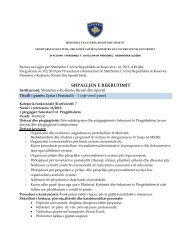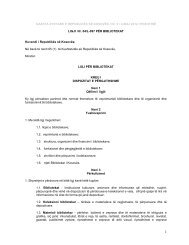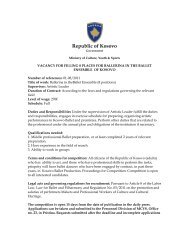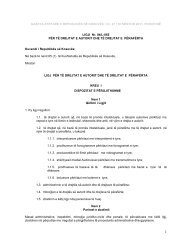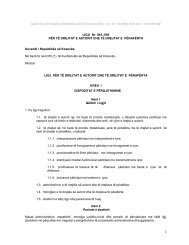Archaeological Guide of Kosovo
Archaeological Guide of Kosovo
Archaeological Guide of Kosovo
Create successful ePaper yourself
Turn your PDF publications into a flip-book with our unique Google optimized e-Paper software.
165<br />
Paldenica<br />
166<br />
Around 150 m on the left side <strong>of</strong> the Pristina-Skopje road, at the entrance<br />
<strong>of</strong> the village <strong>of</strong> Paldenica, above a hill which lays west from the village,<br />
on a terrain configuration <strong>of</strong> a shape <strong>of</strong> a horse, that has a broader overview<br />
<strong>of</strong> wider area <strong>of</strong> Lepenc gorge and the town <strong>of</strong> Hani i Elezit, an amount <strong>of</strong><br />
surface visible remains <strong>of</strong> roman pottery and bricks/tiles has been recorded<br />
in the past. Nevertheless, in 1967, at the area situated in the vicinity <strong>of</strong> the<br />
left river shore <strong>of</strong> Lepenc, couple <strong>of</strong> meters along the river bank stretched<br />
toward the Hani i Elezit, a roman period necropolis was recorded. Numerous,<br />
movable archaeological material was collected and documented at this<br />
recognisance occasion, where a bronze casted belt decorated with glass pasta<br />
in the millefiori technique was found (a glasswork technique which produces<br />
distinctive decorative patterns on glassware). The archaeological material<br />
dates chronologically sometime from the 2nd up to 3rd century AD, this<br />
a time period <strong>of</strong> the construction <strong>of</strong> necropolis <strong>of</strong> Paldenica. On the other<br />
hand, during the agricultural work carried out at the other side located on a<br />
hill part in 1995, a marble engraved and inscribed stele <strong>of</strong> the roman date was<br />
accidentally discovered (2nd- 3rd century AD).The stele has the following dimensions:<br />
160 X 97 X 17,5 cm. Moreover, in another occasion, two bases for<br />
columns were discovered at the same place. Most likely, the site was a roman<br />
date settlement and when considering the surrounding terrain configuration,<br />
presumably, if investigated further, traces <strong>of</strong> a roman road station might be<br />
found somewhere close; it can be assumed since the road that linked ancient<br />
Scupi (Skopje) with Ulpiana, have passed through these parts.<br />
167<br />
Fig. 165. The belt decorated in millefiori technique<br />
discovered in Paldenica (<strong>Kosovo</strong> Museum).<br />
Fig. 166. Roman stele discovered in Paldenica.<br />
Fig. 167. The site location <strong>of</strong> the Paldenica archaeological site.<br />
68 <strong>Archaeological</strong> <strong>Guide</strong> <strong>of</strong> <strong>Kosovo</strong>





